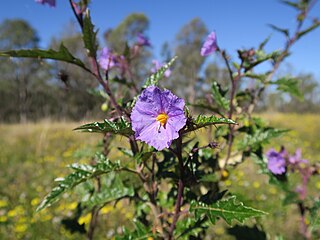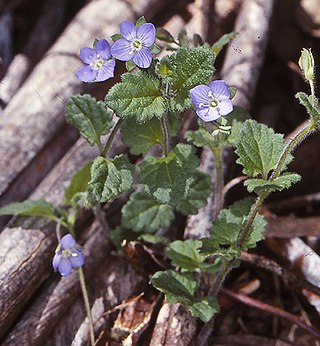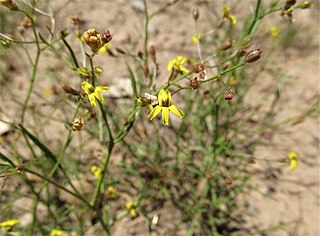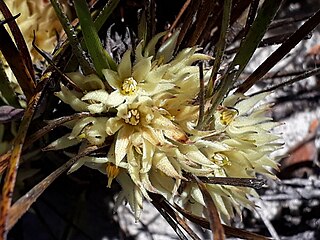
Conostylis setigera, commonly known as bristly cottonhead, is a rhizomatous, tufted perennial, grass-like plant or herb in the family Haemodoraceae and is endemic to the south-west of Western Australia.

Conostylis aculeata, commonly known as prickly conostylis, is a flowering, tufted perennial plant in the family Haemodoraceae. It has flat leaves and yellow, hairy, tubular flowers. It is endemic to the south-west of Western Australia.

Solanum cinereum, commonly known as Narrawa burr, is a species of flowering plant in the family Solanaceae. It has dark green, spiny leaves and purple flowers and grows in open woodland in south eastern Australia.

Veronica calycina, commonly known as hairy speedwell or cup speedwell, is a flowering plant in the family Plantaginaceae. It is a trailing perennial with dark green leaves, purple-blue flowers and is endemic to Australia.

Goodenia coerulea is a species of flowering plant in the family Goodeniaceae and is endemic to the south-west of Western Australia. It is an erect, perennial shrub or biennial herb shrub with linear leaves at the base of the plant, sometimes with a few teeth on the edges, racemes of blue flowers and oval fruit.
Goodenia coronopifolia is a species of flowering plant in the family Goodeniaceae and is endemic to north-western Australia. It is a herb with mostly linear leaves, those at the base of the plant divided with narrow segments, racemes of yellow flowers with brownish-purple markings, and more or less spherical fruit.
Goodenia filiformis, commonly known as thread-leaved goodenia, is a species of flowering plant in the family Goodeniaceae and is endemic to near-coastal areas of south-western Western Australia. It is an erect to ascending herb with cylindrical to narrow linear leaves at the base of the plant and racemes of yellow flowers.

Goodenia glabra, commonly known as shiny pansy or smooth goodenia, is a species of flowering plant in the family Goodeniaceae and is endemic to drier inland areas of Australia. It is a prostrate to low-lying herb with lobed, oblong to egg-shaped leaves, and racemes of yellow flowers with purplish markings.

Goodenia gracilis, commonly known as slender goodenia, is a species of flowering plant in the family Goodeniaceae and is endemic to Australia. It is an annual or perennial herb with linear to lance-shaped leaves and racemes of yellow flowers.

Goodenia humilis, commonly known as swamp goodenia, is a species of flowering plant in the family Goodeniaceae and is endemic to south-eastern Australia. It is a weak, perennial herb with linear to lance-shaped leaves mostly at the base of the plant, and racemes or thyrses of yellow or yellowish-brown flowers.

Goodenia pterigosperma is a species of flowering plant in the family Goodeniaceae and is endemic to south-coastal areas in the south-west of Western Australia. It is an erect to sprawling, glabrous perennial herb or shrub with linear to lance-shaped leaves mostly at the base of the plant, and racemes of dark blue flowers.
Goodenia purpurascens is a species of flowering plant in the family Goodeniaceae and is native to northern Australia and New Guinea. It is usually a perennial herb with linear to lance-shaped leaves at the base of the plant, and thyrses or panicles of purple flowers.
Goodenia quadrilocularis is a species of flowering plant in the family Goodeniaceae and is endemic to south-coastal areas in the south-west of Western Australia. It is an erect, woody perennial herb with egg-shaped to lance-shaped leaves with toothed edges, and racemes of yellow flowers.

Scaevola striata, commonly known as royal robe, is a species of flowering plant in the family Goodeniaceae. It has blue fan-shaped flowers, and is endemic to Western Australia.

Goodenia rotundifolia is a species of flowering plant in the family Goodeniaceae and is endemic to eastern Australia. It is a prostrate to erect perennial herb with more or less round, toothed leaves and racemes of yellow flowers.

Goodenia viscida, commonly referred to as viscid goodenia, is a species of flowering plant in the family Goodeniaceae and is endemic to the south-west of Western Australia. It is an erect perennial herb or shrub with narrow oblong to egg-shaped leaves with toothed edges, and spikes of yellow flowers.

Lechenaultia tubiflora, commonly known as heath leschenaultia, is a species of flowering plant in the family Goodeniaceae and is endemic to the south-west of Western Australia. It is a hemispherical subshrub or more or less erect perennial with crowded, narrow, rigid leaves and variably-coloured, tube-shaped flowers.

Conostylis breviscapa is a rhizomatous, tufted perennial, grass-like plant or herb in the family Haemodoraceae and is endemic to the south-west of Western Australia. It has flat leaves and yellow, hairy, tubular flowers.

Goodenia arguta, commonly known as spur velleia, or grassland goodenia, is a species of flowering plant in the family Goodeniaceae and endemic to continental Australia. It is a glabrous perennial with a rosette of leaves at the base of the plant and ascending flowering stems with deep yellow flowers.

Acrotriche serrulata, commonly known as honey pots, is a species of flowering plant in the family Ericaceae, and is endemic to south-eastern Australia. It is a low-lying, mat-forming shrub with lance-shaped to linear leaves, pale green to whitish, cylindrical flowers and greyish-green fruit.

















